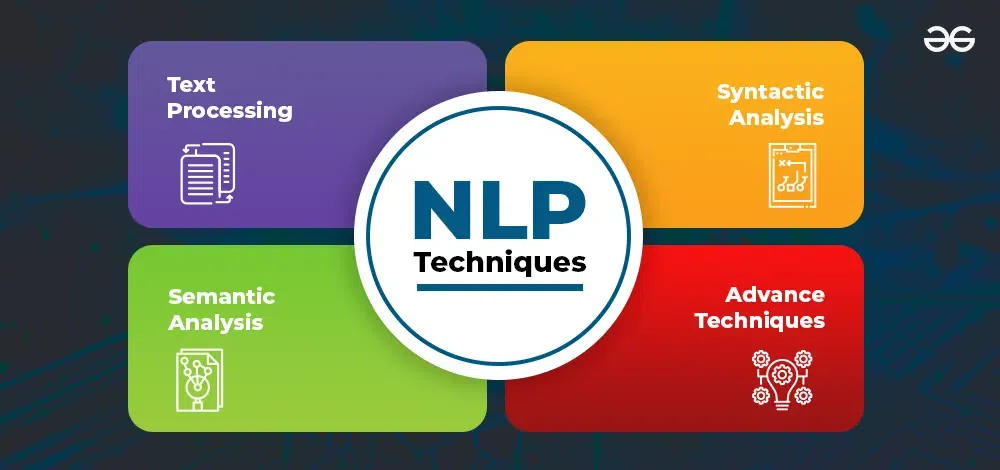
|
|
Natural Language Processing (NLP) is a branch of artificial intelligence that focuses on the interaction between computers and humans through natural language. The ultimate objective of NLP is to read, decipher, understand, and make sense of human languages in a valuable way.  NLP Techniques Here, we will delve deeper into the various techniques and methodologies used in NLP, along with their applications and significance, accompanied by practical examples. Table of Content 1. Text PreprocessingText preprocessing is the first and one of the most crucial steps in any NLP task. It involves cleaning and preparing the text for analysis. Tokenization Tokenization is the process of breaking down a text into smaller units called tokens. Tokens can be words, sentences, or subwords.
Stop Words Removal Stop words are common words that usually do not add significant meaning to a sentence and are often removed to reduce the dimensionality of the data.
Stemming Stemming is the process of reducing words to their root form.
Lemmatization Lemmatization also reduces words to their base or dictionary form but is more sophisticated than stemming. It considers the context and converts the word to its meaningful base form.
2. Syntactic AnalysisSyntactic analysis involves parsing the structure of sentences to understand their grammatical structure. Part-of-Speech Tagging (POS) POS tagging involves labeling each word in a sentence with its corresponding part of speech, such as nouns, verbs, adjectives, etc.
Dependency Parsing Dependency parsing involves understanding the dependencies between words in a sentence. It establishes the relationships between “head” words and words that modify those heads.
Chunking Chunking, also known as shallow parsing, groups words in a sentence into meaningful “chunks.” These chunks typically represent noun phrases, verb phrases, etc.
3. Semantic AnalysisSemantic analysis focuses on understanding the meaning of the text. Named Entity Recognition (NER) NER involves identifying and classifying named entities in text into predefined categories such as names of people, organizations, locations, dates, etc.
Sentiment Analysis Sentiment analysis determines the sentiment expressed in a text, which can be positive, negative, or neutral.
Word Sense Disambiguation (WSD) WSD identifies the correct meaning of a word based on its context.
4. Advanced TechniquesAdvanced NLP techniques involve more complex and nuanced processing. Topic Modeling Topic modeling is a technique to discover abstract topics within a collection of documents. One of the most popular algorithms for topic modeling is Latent Dirichlet Allocation (LDA).
Text Classification Text classification involves categorizing text into predefined categories.
Machine Translation Machine translation is the task of translating text from one language to another.
Summarization Summarization involves producing a concise summary of a longer text while preserving the main ideas.
5. Deep Learning ApproachesDeep learning has revolutionized NLP, enabling more sophisticated models and applications. Recurrent Neural Networks (RNNs) RNNs are designed for sequential data like text, where the output depends on the previous computations.
Long Short-Term Memory Networks (LSTMs) LSTMs are a type of RNN that can capture long-term dependencies and context in text. They are used in tasks like machine translation, text generation, and speech recognition.
Transformer Models Transformers, such as BERT, GPT-3, and T5, use self-attention mechanisms to handle context more effectively. They have set new benchmarks in various NLP tasks, including translation, summarization, and question answering.
Sequence-to-Sequence Models Sequence-to-sequence models are used for tasks where the input and output are sequences, such as translation and summarization. These models often use encoder-decoder architectures, where the encoder processes the input sequence and the decoder generates the output sequence.
Practical Applications of NLPNLP techniques are applied in a wide range of practical applications that impact our daily lives. Chatbots Chatbots are automated conversation agents that use NLP to understand and respond to user queries. They are widely used in customer service, virtual assistants, and interactive websites.
Search Engines NLP enhances search engines by improving the relevance of search results. Techniques like semantic search help in understanding user intent and providing more accurate answers.
Voice Assistants Voice assistants like Siri, Alexa, and Google Assistant use NLP to understand voice commands and respond appropriately. They rely on speech recognition, language understanding, and dialogue management.
Content Recommendation NLP is used in content recommendation systems to suggest articles, videos, and products based on user preferences and behaviors. These systems analyze text content to determine user interests.
ConclusionNatural Language Processing is a rapidly evolving field with a wide array of techniques and applications. From basic text preprocessing to advanced deep learning models, NLP enables machines to understand and interact with human language in increasingly sophisticated ways. As technology continues to advance, NLP will play an even more critical role in bridging the gap between humans and machines, making interactions more seamless and intuitive. |
Reffered: https://www.geeksforgeeks.org
| AI ML DS |
Type: | Geek |
Category: | Coding |
Sub Category: | Tutorial |
Uploaded by: | Admin |
Views: | 16 |